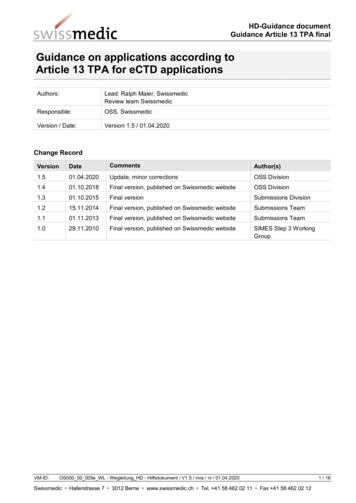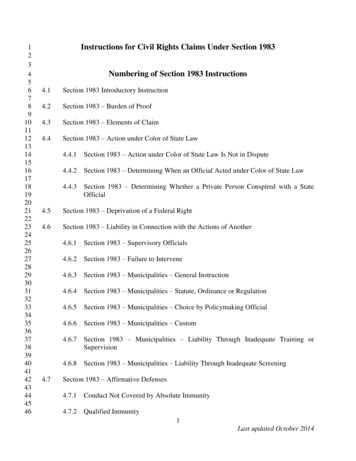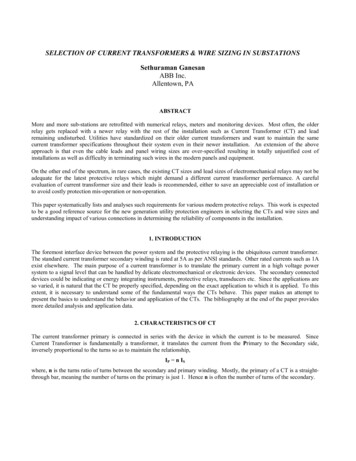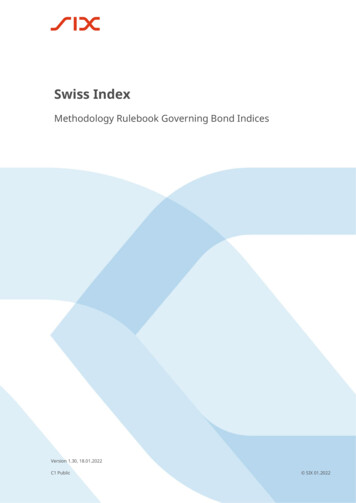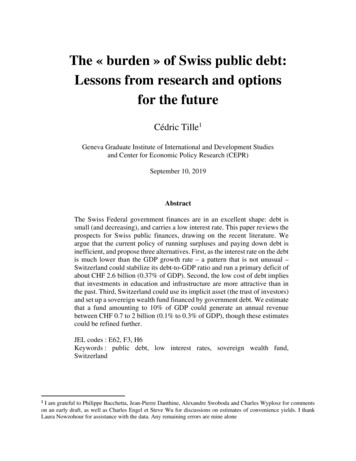
Transcription
The « burden » of Swiss public debt:Lessons from research and optionsfor the futureCédric Tille1Geneva Graduate Institute of International and Development Studiesand Center for Economic Policy Research (CEPR)September 10, 2019AbstractThe Swiss Federal government finances are in an excellent shape: debt issmall (and decreasing), and carries a low interest rate. This paper reviews theprospects for Swiss public finances, drawing on the recent literature. Weargue that the current policy of running surpluses and paying down debt isinefficient, and propose three alternatives. First, as the interest rate on the debtis much lower than the GDP growth rate – a pattern that is not unusual –Switzerland could stabilize its debt-to-GDP ratio and run a primary deficit ofabout CHF 2.6 billion (0.37% of GDP). Second, the low cost of debt impliesthat investments in education and infrastructure are more attractive than inthe past. Third, Switzerland could use its implicit asset (the trust of investors)and set up a sovereign wealth fund financed by government debt. We estimatethat a fund amounting to 10% of GDP could generate an annual revenuebetween CHF 0.7 to 2 billion (0.1% to 0.3% of GDP), though these estimatescould be refined further.JEL codes : E62, F3, H6Keywords : public debt, low interest rates, sovereign wealth fund,Switzerland1I am grateful to Philippe Bacchetta, Jean-Pierre Danthine, Alexandre Swoboda and Charles Wyplosz for commentson an early draft, as well as Charles Engel et Steve Wu for discussions on estimates of convenience yields. I thankLaura Nowzohour for assistance with the data. Any remaining errors are mine alone
Executive summaryThe Swiss Confederation’s finances are in an excellent shape. We are far from the challengingtimes of the 1990’s that had rightly led to the adoption of a debt brake mechanism. While publicfinances in most advanced economies have worsened over the last 10 years, Switzerland is anexception. The Federal government’s debt is low (currently 14.5% of GDP) and has substantiallydecreased since the mid-2000’s, as the Swiss government repaid nearly one-fifth of its outstandingdebt. Forecasts show a continuing decrease of debt in coming years. In addition, the cost of thedebt is at exceptionally low levels: investors are willing to pay to put their funds with the SwissConfederation even at very long horizons. Against such an environment it makes sense to re-assessthe options available in light of recent research works.This paper presents a review of recent contributions in the context of Switzerland. The last tenyears have seen active research work on public finances in advanced economies. This hassubstantially been driven by the exceptionally low level of interest rates on sovereign debt (withthe exception of countries affected by the euro crisis). In his AEA presidential address in January2019, Olivier Blanchard stressed that public debt is manageable and does not constitute a majorproblem for economic policy.A first point stressed by research is that the level of interest rates has been on a downwards trendsfor several years, even when controlling for the impact of inflation and business cycles. Thisphenomenon is observed in the majority of advanced economies, including Switzerland, and isdriven by structural factors that are likely to persist. In particular, the demand for safe assetskeeping their value even in times of global crisis has substantially increased since the start of theGlobal Financial Crisis.A second point is that interest rates on sovereign debt are lower than the growth rates of GDP. Agovernment can then afford a primary deficit (deficit before the payment of interest on the debt)while keeping the ratio of debt-to-GDP steady, this ratio being the economically relevant indicatorfor debt sustainability. Even though this gap between interest rates and growth is not homogenouslyseen across advanced economies, it is clearly relevant for Switzerland.A third point is that the decrease of the yields of sovereign bonds appears larger than the decreaseobserved for private bonds. While this point remains generally debated, we observe some wideningof the private-sovereign gap in Switzerland.This favorable background, which is likely to persist, opens new options for Swiss public finances.We stress three of them.First, the sizable gap between the interest rate on public debt and the growth rate of GDP impliesthat Switzerland can afford a primary deficit and still keep the debt-to-GDP ratio at its current lowlevel. A simple computation indicates that an annual deficit of CHF 2.6 billion is feasible.2
Second, public investments in infrastructure, education or research can be funded on very favorableterms given the low level of interest rates. While it is difficult to quantify precisely the return onthese investments, it has likely increased with the need to train the labor force for the challenges ofthe digital economy, as well as the need to improve energy efficiency. The gap between thesereturns and the decreasing cost of debt has thus widened compared to the past.Third, the low level of interest rates asked by global investors from the Swiss Confederation raisesthe question of whether to set up a sovereign wealth fund. Such a fund would be funded bygovernment bonds and invested in higher-return asset. While in the Swiss context the question ofa sovereign wealth fund is often raised in relation to the large size of the Swiss National Bank’sbalance sheet, it is important to treat a fund as clearly distinct from the central bank, because thetwo institutions have profoundly different mandates. This paper considers a range of possiblereturns that a fund could generate and contrasts them with the interest cost on debt. This analysisshows that a fund amounting to 10% of annual GDP could generate an annual gain between CHF0.7 billion and CHF 2 billion. These estimates give an order of magnitude and should be completedwith finer analyses to get a more precise picture. It is important to carefully design the governancestructure of a sovereign fund so that it can focus on its main task. These governance challenges arehowever manageable and can build on the mechanisms put in place in institutions facing similarchallenges, such as central banks.In addition to these points focusing on the long-term trends of public finances, the last decade haveseen a rich number of academic contributions on whether fiscal policy is appropriate as a tool tomanage the short-term business cycle. This research shows a substantial degree of heterogeneity inpolicy effectiveness, depending on the exact tools used and the economic situation. A broadmessage is that fiscal policy is more effective when aimed at households facing credit constraints,as they have a high propensity to consume. In addition, a fiscal expansion is more beneficial whenmonetary policy faces constraints such as the zero lower bound on interest rates. In such situationsthe central bank will tend to welcome the inflationary effect of an expansionary fiscal policy. Thestudies also show the need to rely on automatic stabilizers and preset rules given the relatively slowpace of decision processes for fiscal policy.The strong situation of Swiss public finances is an opportunity. It can be put to good use withoutputting debt in a dangerous dynamics, and without putting the debt brake into question. While acautious policy was fully adequate after the sharp worsening of public finances in the 1990’s, thesituation has since profoundly changed and we have moved from a debt brake to a shift in reversegear since several years. Even the International Monetary Fund stresses the need to make good useof the available room for maneuver.3
Table of contents1. Introduction . 62. Clarification of concepts . 92.1.Debt dynamics . 92.2.Financial assets held by the government . 92.3.Theoretical analysis . 103. Results from the literature. 123.1.Introduction . 123.2.The downward trend in interest rates . 123.2.1.General points . 123.2.2.The Swiss case . 143.3.Interest rates and growth . 163.3.1.General points . 163.3.2.The Swiss case . 173.4.Public and private interest rates . 193.4.1.General points . 193.4.2.The Swiss case . 203.5.Synthesis for Switzerland . 233.5.1.Main points . 233.5.2.Options for economic policy . 233.5.2.1. Higher deficit. 243.5.2.2. Additional investments . 253.5.2.3. Financial investments . 264. A sovereign wealth fund for Switzerland? . 274.1.Introduction . 274.2.A particular fund . 274.3.Potential return on the fund . 294.3.1.Portfolios . 294.3.2.Average returns and volatility . 304.3.3.How much would a sovereign wealth fund yield? . 354.4.Governance issues . 364
5. Impact temporary policies . 395.1.Introduction . 395.2.Theoretical aspects . 395.3.A contrasted effectiveness . 415.4.Fiscal consolidation strategies . 435.5.Synthesis. 436. Conclusion . 457. References . 468. Appendix . 508.1.Data sources . 508.2.Public debt dynamics . 528.3.A simple macroeconomic model . 538.3.1.Main features. 538.3.1.1. Consumer’s utility . 538.3.1.2. Production and firms’ optimization . 538.3.1.3. Government . 538.3.1.4. Household’s optimization . 548.3.1.5. Market equilibria. 558.3.2.Balanced growth path . 558.3.2.1. Ratios relative to GDP . 558.3.2.2. Interest rate on government bonds . 568.3.2.3. Numerical examples . 578.4.Returns on the sovereign wealth fund’s assets . 605
1.IntroductionIn his AEA presidential address in January 2019 Olivier Blanchard stressed that the increasein sovereign debt levels seen in many countries should not necessarily be seen as a cause for alarm(Blanchard 2009a,b). Focusing on the United States he shows that economic growth is strongenough to stabilize the ratio of public debt-to-GDP, which is the appropriate indicator for analyzingdebt sustainability. The GDP growth rate currently exceeds the interest rate that the governmentpays on its debt, a gap that is far from being the exception. He concludes that while debt is not free,the alarmist view that is often seen in the debate is not warranted.Blanchard’s point is particularly relevant for Switzerland that has experienced a veryfavorable financial situation for many years (Soguel 2009). Figure 1 shows that the Swiss Federalgovernment’s (Confederation) debt has substantially decreased since 2002, moving from 25.6% ofGDP (CHF 120.4 billion) to 14.5% in 2017 (CHF 97.1 billion). 2 Forecasts by the Swiss FederalFinance Administration indicate an additional decrease until 2022, and debt should by then onlyamount to 11% of GDP (CHF 83.5 billion).Figure 1: Swiss Federal Government's debt(forecasts since 2018)30%140Billion Swiss francs12025%10020%8015%60% of GDP10%405%20019900%199520002005201020152020This decrease of the debt-to-GDP ratio is driven both by GDP growth and, to a large extent,by the government paying down its debt. The debt has decreased by CHF 23 billion over 15 years,which represents one-fifth of its initial amount, and forecasts shows additional reductions of morethan CHF 13 billion over the next 5 years.2The sources for the data used in this paper are listed in the appendix at the end.6
A second relevant aspect is that the Swiss Confederation funds its debt on very good terms.Figure 2 shows the nominal yields on Federal government bonds of different maturities. We clearlysee that they have fallen and are currently at historical lows. Investors are currently willing to paythe Swiss government for being able to put their money with it even over long periods. The figuresfor August 2019 show that investing at an horizon of 10 years costs investors 0.98% per year, thecost being of 0.69% at a maturity of 20 years and 0.57% at a maturity of 30 years. In other words,investors treat Swiss government bonds as a safe and are willing to pay a rental fee to put theirmoney there.Figure 2: Yield on Swiss Federal government bonds by maturity10%8%6%1 year5 years4%10 years20 years2%0%199019952000200520102015-2%The very low level of public debt and favorable funding terms raise the question of whetherthe debt brake mechanism in place in Switzerland should be adjusted, as this mechanism has showna bias toward budgets surplus in practice. A recent report recognizes the issues but recommendsagainst major changes (Brülhart and al. 2017). Tille (2017) presents a critical assessment of thereport. A recent analysis by the IMF in their article IV report on Switzerland (2019) also stressesthat a more flexible approach to public finances should be taken, without fundamentally puttingthe debt brake into question.This paper takes stock of the Swiss situation in light of recent research on public debt. Wefirst document that the global downward trend in interest rates is also present in Switzerland, evenafter controlling for inflation and the business cycle. While interest rates on private borrowing havealso decreased, they have done so by somewhat less than for government bonds. We then showthat the interest rate on Swiss government bonds is substantially below the GDP growth rate, and7
this pattern has been the norm historically with the 1990’s being the exception. In light of this gap,we estimate that Switzerland can keep the debt-to-GDP ratio stable at its current low value and stillrun an annual primary deficit of CHF 2.6 billion.The favorable funding terms faced by the Swiss Confederation also raise the option ofestablishing a sovereign wealth fund that would be financed by debt and invest in higher yieldingassets. We consider a broad range of investment options and estimate that a fund amounting to 10%of annual GDP could generate an annual gain between CHF 0.7 billion and CHF 2 billion. Whilethe idea of a sovereign wealth fund has been raised on several instances in recent years, the debatelinks it to the large balance sheet of the Swiss National Bank. By contrast this paper considers afund that is entirely distinct from the central bank given that the two institutions have profoundlydifferent mandates.The paper is structured as follows. The next section clarifies the key concepts, with anemphasis on long run patterns. Section 3 reviews the main aspects identified in the literature andapplies them to Switzerland. Section 4 assesses whether Switzerland should take advantage offavorable funding terms by setting up a sovereign wealth fund, and discusses the potential returnsas well as governance issues. Section 5 reviews the recent literature on the role of fiscal policy asa business cycle stabilization tool. Section 6 concludes.8
2.2.1.Clarification of conceptsDebt dynamicsThe starting point of our analysis is the dynamics of public debt. For brevity we focus on themajor aspects and leave a more detailed presentation to the appendix at the end of the paper.We denote the ratio between public debt and GDP at the end of a year s by 𝑏 . This ratio isthe relevant measure for the analysis as it reflects both the amount of debt and the income generatedby the economy. The nominal interest rate on the debt is denoted by 𝑖 , and the nominal GDPgrowth rate by 𝜇 . The primary deficit is denoted by 𝑑 (as a ratio to GDP). The dynamics of thedebt-to-GDP ratio are then written as:𝑏𝑏𝑑𝑖1𝜇𝑏𝜇1The debt ratio can increase for two reasons. First, additional borrowing is needed if taxes do notcover non-interest spending. Second, the interest payments on the debt increase its level. Interest𝜇0).payments lead to an increase of the ratio if they exceed the pace of growth (that is if 𝑖Interest payments increase indebtedness but economic growth reduces it.Equation (1) shows that a stabilization of the ratio between debt-to-GDP (𝑏𝑏0)leads to a relation between the primary deficit and the gap between the interest rate and the growthrate:𝑑𝑖1𝜇𝑏𝜇2If the interest rate exceeds the growth rate (𝑖𝜇 ), stabilization requires a primary surplus (𝑑0). However, the debt-to-GDP ratio can be stabilized even with a primary deficit if the interest rateis smaller than the GDP growth rate (𝑖𝜇 ).The central point of Blanchard (2009a,b) is to show that in the United States the mostcommon pattern is an interest rate below the growth rate (𝑖𝜇 ). Whereas this is clearly the casesince the global crisis, the pattern is also quite common historically.2.2.Financial assets held by the governmentThe analysis can easily be extended to a case where the government purchases assets inaddition to issuing debt. We denote the ratio between assets and GDP by 𝑓 and the nominal interestrate earned on the assets by 𝑖 . The dynamics of the government’s net debt are then given by amodified version of equation (2):9
𝑖𝑓𝜇3As before the dynamics of net debt reflect the primary deficit and the gap between the interest rateon government liabilities and the GDP growth rate. A new element is that difference between theinterest rate that the government earns on its asset and the one that it pays on its liabilities. Thedebt-to-GDP ratio can be stabilized despite a primary deficit if the interest rate on liabilities islower than GDP growth (𝑖𝜇0) or if the government earns a higher return on its assets (𝑖0).𝑖2.3.Theoretical analysisBefore turning to the Swiss case, we assess how the gap between different interest rates andthe gap relative to the GDP growth rate can arise in a standard macroeconomic model. For brevitywe focus on the key elements and leave a detailed presentation to the appendix.The economy is inhabited by a representative household who consumes, supplies a setamount of labor to a firm, and accumulates capital that she rents to the firm. In addition to capitalthe household can invest in private bonds and government bonds. The government raises taxes,spends, issues bonds, and can purchase private bonds.Two elements are central to the analysis. The first, and most important one, is that thehousehold’s utility is affected not only by consumption but also by her holdings of governmentbonds. This is a simple way to capture the convenience yield of public bonds, which provide moreliquidity and safety than private bonds do. 3 This special benefit from government bonds impliesthat the interest rate on them is always smaller than the one on private bonds (𝑖𝑖 ). The secondelement is that the government can invest in private bonds in addition to issuing its own.The equilibrium of the model gives the interest rates on sovereign and private bonds. Theyreflect productivity growth, the household’s discount rate, and the special nature of governmentbonds (i.e. their direct impact on utility). We can then assess the impact of changing variousparameters based on a numerical illustration presented in the appendix. This exercise is meant tobe illustrative and does not reflect a fine calibration of the Swiss economy – an exercise that wouldrequire a much more detailed model. The main findings from the analysis are as follows:- A decrease in public debt increases the gap between the interest rates on private andgovernment bonds, 𝑖 𝑖 , reduces the gap relative to GDP growth, 𝑖𝜇 , as well asthe primary balance 𝑡𝑔 required to stabilize the debt-to-GDP ratio.- An increase in public debt that is reinvested in private bonds reduces the interest rate gap,𝑖 𝑖 , as well as the primary surplus 𝑡𝑔 needed for stabilization. This last aspect is3This modelling approach is identical to the standard “money in the utility function” assumption to capture thetransaction benefits from money holdings.10
---impacted by the sensitivity of the household’s portfolio allocation between governmentand private bonds to the interest rate differential, an aspect that is hard to quantify withprecision.An increase in the household’s patience, for instance reflecting greater uncertainty, raisesits propensity to save and lowers interest rates. While the impact on the interest rate gap𝑖 𝑖 is limited, the gap relative to the growth rate 𝑖𝜇 is substantially reduced,𝑔 needed to stabilize the debt-to-GDP ratio.which lowers the primary surplus 𝑡An increase in the utility that the household directly gets from holding government bonds,for instance reflecting a scarcity of safe assets, reduces the interest rate on these bonds. Itincreases the interest rate gap, 𝑖 𝑖 , reduces the gap vis-a-vis growth, 𝑖𝜇 , as wellas the primary balance 𝑡𝑔.A decrease in the productivity growth rate lowers all interest rates, but has only a limitedimpact on the difference between the various interest rates, as well as on the differencebetween interest rates and the growth rate.11
3.3.1.Results from the literatureIntroductionThis section presents a focused review of the main recent research contributions on interestrates on government bonds, and illustrates them in the Swiss context. We start with the downwardstrend in equilibrium interest rates – adjusted for inflation and the business cycle – and then considerthe gap between the interest rate and GDP growth, before turning to the gap between interest rateson government and private bonds.3.2.The downward trend in interest rates3.2.1. General pointsA major development in advanced economies since more than a decade has been thesubstantial decrease of interest rates in government bonds. While the case of the United States hasbeen the object of many contributions, it is far from isolated. Bean and al. (2015) show that thepattern is observed in most advanced economies (with of course the exception of the ones thatsuffered from a crisis, such as Greece). Del Negro and al. (2019) undertake a statistical analysis toidentify the component of the interest rate that is common across countries and document a sizabledecrease of that global factor. While the downward trend has picked up in the last ten years, it hadalready been present since the 1980’s, which shows the presence of structural drivers.It is important not to just look at nominal interest rate, as in figure 2, but to take account ofinflation and the business cycle. Advanced countries have seen a sizable decrease in inflation sincethe 1980’s. As nominal interest rates include a compensation for inflation, that decrease is of coursemechanically reflected in lower interest rates. We thus need to consider real interest rates. Anadditional element is the need to correct for the business cycle, as the real interest rate is lowerduring recessions without this necessarily reflecting a long-term trend.The literature has thus focused on the so-called equilibrium real interest rate, also referred toas the natural rate, which is the real interest rate that would prevail if the economy was growing atits potential growth rate, thus being neither overheating nor in recession. This natural rate cannotbe directly observed but can be estimated based on models. Laubach and Williams (2015)developed an approach that is now standard. They apply it to the United States and conclude thatthe natural rate has markedly decreased, even before the global crisis, in part because of a decreaseof the potential growth rate of GDP. Holston, Laubach and Williams (2018) reach a similarconclusion for other advanced economies, as do Del Negro and al. (2019, 2018) based on a broadersample of countries.12
There are several underlying causes for this trend. The first is a decrease in the long termgrowth rate of GDP, primarily because of the slowdown in productivity growth seen over the lastdecade. Demographic factors also play a role. Gagnon, Johannsen and Lopez-Salido (2016) showthat the retirement of the baby-boom generation reduces the labor supply, while the capitalaccumulated in the past remains in place. The economy is then left with abundant capital whichreduces its rate of return and interest rates. Rachel and Summers (2019) review a broad range ofdrivers that impact the propensity to save of households. They conclude that without the increasein public deficits over the last ten years, the decrease in interest rates would have been even morepronounced. While lower potential growth plays a role, Rachel and Summers (2019) stress that thisis a rather recent element while the decrease in interest rates started well before.Another element is the demand from investors for safe assets that keep their value evenduring systemic crises. Caballero, Farhi, and Gourinchas (2017) show an imbalance since thebeginning of the global crisis between a growing demand and a shrinking supply. Before the crisissafe assets consisted of sovereign debts and structured products developed by financialintermediaries using advances in financial engineering. The crisis sharply changed theenvironment. The number of countries where sovereign debt can be considered safe hassubstantially decreased. In addition, the reliability of structured products as safe assets turned outto be much weaker than expected. This led to a sharp decrease in the supply of safe assets at a timewhen demand kept increasing, leading to lower interest rates on these assets. In a detailed study ofthe euro area Brunnermeier and al. (2016) make a proposal to increase the supply of safe a
decreased since the mid-2000's, as the Swiss governme nt repaid nearly one-fifth of its outstanding debt. Forecasts show a continuing decrease of debt in coming years. In addition, the cost of the debt is at exceptionally low levels: investors are willing to pay to put their funds with the Swiss Confederation even at very long horizons.



